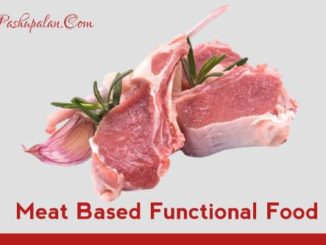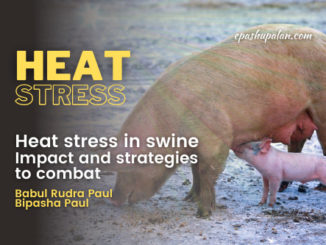Global livestock production is growing more dynamically than any other agricultural sector. Livestock sector plays a critical role in the welfare of India’s rural population. Pig production, among other species has a high potential to contribute to high economic gain. This is because of two reasons: First the pigs have high fecundity, high feed conversion efficiency, early maturity, short generation interval and relatively small space requirement. Secondly, they are multipurpose animals providing about 40% of meat consumed in the world market, and by-products like pig dung as manure and bristle for brush industry. Pork is the most popular meat consumed in the world today. Pig population in India is estimated to be 9.06 million and it ranks 5th in the world. 20th Livestock census of India pigs comprises 1.69% to the total livestock population (http://dahd.nic.in). Pig rearing has the potential to form an important and inclusive farm practice which can help socio-economic backward section of the society and poor farmers to attain stability of nutritional status at a comparatively low expenditure and also obtain a sustainable source of income by fulfilling the ever increasing demand for the pork. Out of the total pigs 23.85% (1.90 million) are either exotic or crossbred and rest indigenous. 89.62% (7.16 million) of the total pigs are found in rural areas. The salient features of pig production system are as following—
- Pig farming has been adopted by small and landless farmers, and mainly in tribal areas.
- Pig production is small-scale, backyard, market-oriented enterprise.
- Pigs are mainly dependent on locally available feed resources/vegetations, crop residues and kitchen waste, which are of low or no cost.
- Producers have inadequate knowledge about feeding, breeding, health care and managemental practices.
- It is low input activity relying mainly upon women’s labour for rearing.
- Most of pig sty are located in backyard of house and the unhygienic conditions of these building predispose pigs to diseases.
- Best breeding stock rarely goes to the market, resulting in the use of a foundation stock with poor breeding qualities.
- There is less availability of improved breeds from government farms and increased use of own stock and that of neighbors, which gives rise to inbreeding and consequently low productivity.
- A wide gap still exists between the need vs demand and availability of pork. The major reason for that the pigs reared by the farmers are of the nondescript local breed, whose growth rate is claimed to be poor, and hence, their production is inadequate.
- There is lack of proper housing and shelter under low-input traditional system thus exposing pigs to adverse weather conditions like high temperatures and rain.
- The commercial pig production system in India is characterized by improved crossbred/ exotic breeds of pigs that can be bred and reared under confinement.

Inherent merits of pig farming as compared to other livestock species
Pig rearing has higher potential to contribute to more economic gain for small, marginal farmers or rural poor belonging to the lowest socioeconomic strata due to its following advantages:
- Better feed conversion efficiency of pigs i.e. they attain more unit weight gain per kg of feed consumed as compared to other meat producing animals except broilers.
- Higher fecundity in pigs – produces 6 – 12 piglets in each farrowing.
- Pigs reach sexual maturity at an early age. A sow can be bred as early as 8 – 9 months of age and can farrow twice in a year under optimal management conditions.
- Pigs have shorter generation interval as compared to other classes of livestock
- Quick returns since the market weight of 60-90 kg can be achieved in a period of 6-9 months.
- Converts damaged feeds which are either not edible or not very palatable to human beings into valuable nutritious meat.
- Apart from providing meat, it is also a source of bristles and manure.
- Can survive and grow on wide variety of feed stuff like grains, vegetables, fruits, fodder, sugarcane, and kitchen waste.
- Offers employment opportunities to seasonally employed rural farmers and supplement income to improve their living standards
- Require little initial investment on building and gear.
- Pig products range from primary commodities such as pork, to processed food products such as sausages, smoked hams to cooked salted ears, and other snack foods.
- Demand for pigs fat in poultry feed, soap, paints and other chemical industries.
- The small scale pig sector has seemingly greater potential to reduce poverty.
- Pigs are potential source of animal proteins and avenues for additional income vis a vis employment that can improve the livelihood in a sustainable manner.
Conclusion
Presently, our pig production system has many lacunae namely absence of sufficient number of breeder farmers, tendency of the pig grower to raise pig to marketable age on negligible inputs and lesser preference of the consumers for pork from the local pigs etc. Absence of sufficient number of breeder farmers throughout the country is also a major constraint leading to lesser availability of quality pigs for fattener farmers and market. Therefore, genetic improvement of indigenous pigs must be undertaken on priority for production of superior germplasm. Selective breeding and crossbreeding has to be expanded for improving production and productivity. There is need for strengthening the pork marketing mechanisms at the local level to the marketing channels, and integrate production programmers with slaughterhouses to ensure better sustainability. Pig farming has the potential to have a positive impact on the livelihood of millions of resource poor, under-privileged, landless and marginal farmers.







3 Trackbacks / Pingbacks